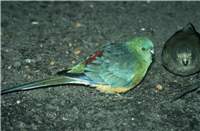Family
Psittacidae
Genus
Psephotus
Species
haematonotus
Threats/Control Methods - Regional
The population numbers of these parrots may be in decline due to increasing competition for nest hollows from Common Mynas (Acridotheres tristis ). The Crested Pigeon (Ocyphaps lophotes ) also competes with the species for food.
Threats/Control Methods - Local
The growing number of busy roads is leading to increased road deaths. Domestic pets are also threatening the bird's survival.
Local/Urban Actions
Canberra residents can encourage these beautiful birds into their local area by insuring domestic pets are not a threat. Cat owners can providing a stimulating indoor or enclosed environment for them to enjoy to preventing hunting opportunities. Red-rumped Parrots may utilise a wooden nest box if installed, however, care must be taken not to encourage the Common Myna (Acridotheres tristis ). Try a box 3-10 meters up with a 6cm entrance diameter and an inside diameter of 14cm. If Mynas are a problem in your area, it is also possible to purchase, rent, or download designs for humane Myna traps. Check http://sres-associated.anu.edu.au/myna/trapping.html
Common Names
Red-rumped Parrot, Grass Parrot
Distinguishing Features
The Red-rumped Parrot is a medium bird of 26-28cm. The male bird is brightly coloured with a green head, yellow underbelly, blue-green tail and mostly blue wings. Its red rump is seen clearly as it spreads its wings. The female is a much duller olive green colour, providing a very good camouflage. Young birds are also dull in colour.
Survey Techniques
Call and visual identification.
Species Call
A sharp, metallic, scratchy and abrupt 'chwie-chwiep or a soft, soft whistle.
Similar Species
This parrot is smaller and less obvious than other common parrots in the region.
Distribution
This species is only found in the eastern corner of mainland Australia, throughout all of NSW, VIC and in SA to Adelaide.
Country of Origin
Australia.
Conservation (Pet/Pest) Status - Regional
The population numbers have fluctuated over the past 20 years and are declining overall (COG).
Conservation (Pet/Pest) Status - National
Secure, not listed under the EPBC Act 1999.
LSCCES Population
Only moderate values were recorded in Civic West (West Basin surrounds) with low values in NMA, Black Mt. and ANU.
Associated vegetation community
This small ground-foraging parrot prefers open or lightly timbered grasslands, mallee forests and farmlands.
Limiting Resources
This species needs an area with a plentiful ground seed and water supply. Resources need to be a good distance away from roads and heavy traffic areas, as its ground foraging habitat leaves it susceptible to being hit. It requires an area free from predators such as domestic pets or European Red Foxes (Vulpes vulpes). It depends on nesting hollows that are also sought by the strong and growing population of Common Mynas (Acridotheres tristis ) in the region.
Breeding
The female Red-rumped Parrot finds a suitable eucalypt tree hollow for nesting and lays about 5 white eggs. She incubates these for 3 weeks while being feed by the male. The young stay in the nest for one month and are cared for by both parents. In the Canberra region, nesting activities begin in mid September and end in late January.
Behaviour
These birds are most often seen feeding in large flocks on the ground under trees on ovals and nature strips. They are fairly sociable and are happy to feed with other medium-sized parrots, including Galahs (Cacatua roseicapilla ) and Eastern Rosellas (Platycercus eximius ).
Functional Group
Food Species
Red-rumped Parrots forage on the ground for seeds. They will also eat fruits, seeds and flowers on trees.
Predators
Domestic pets such as Dogs (Canis familiaris) and Cats (Felis catus) are known to injure or kill parrots. They are also susceptible to attacks from European Red Foxes (Vulpes vulpes).
Interesting Fact
These parrots are popular aviary birds and escaped birds are increasing the populations of wild birds around Sydney and the Central Coast NSW.
References - (reader suitability of references, P=Primary teachers, S=Secondary students, T=Tertiary students and researchers)
Books:Delgale, J. 1997. Attracting Birds to your Garden in Australia. New Holland Publishing. NSW. P, S, T
Morcomber, M. 2000. Field guide to Australian Birds. Steve Parish Publishing, Archerfield. P, S, T
Pizzey, G. 2000. The Graham Pizzey & Frank Knight Field Guide to the Birds of Australia. Angus & Robertson, Sydney. P, S, T
Veerman, P. 2003. Canberra Birds: A report on the first 21 years of the garden bird survey. Philip Veerman and Canberra Ornithologists Group. Canberra. S, T
Internet: Birds in Backyards. 2006. [online]. Available at:http://www.birdsinbackyards.net P, S, T
Canberra Ornithological Group (COG). 2004. Birds of Canberra Gardens. COG and the ACT Department of Urban Services. [online]. Available at:http://garden.canberrabirds.org.au/ P, S, T
Online Publications:Nix, H. and Cunningham, R. 2006. Birds of the Lower Sullivans Creek Catchment, Canberra ACT. Prepared for the Life in the Suburbs project using data from the Lower Sullivans Creek Catchment Ecological Survey (LSCCES). Australian National University. Canberra. [online]. Available at: http://www.lifeinthesuburbs.com.au/category.php?id=65 S, T
Olsen, P. et al. 2005. The State of Australia's Birds 2006: Invasive Species. Supplement to Wingspan 16:4. Birds Australia. [online]. Available at: http://www.birdsaustralia.com.au/soab/SOAB2006.pdf S, T
Tidemann C. 2002. Mitigation of the Impacts of Mynas on Biodiversity and Public Amenity. [online]. Available at: http://sres.anu.edu.au/associated/myna/minimise_files/Myna_Mitigation_PhaseI.pdf T

 Top
Top Top
Top